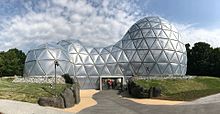Kleinwelka Dinosaur Park

The Kleinwelka Dinosaur Park is the largest dinosaur park in Germany with 16 hectares. The facility, unique in its size and type, is located between the Bautzen districts of Kleinwelka and Großwelka . It emerged from the directly adjacent Großwelka dinosaur garden . In the two facilities there are over 200 life-size sculptures of dinosaurs and other primeval creatures, especially reptiles , amphibians and mammals from prehistoric, stone and modern times .
development
The history of the dinosaur park begins in the neighboring Großwelka dinosaur garden. On his property in Großwelka, Franz Greeting began modeling primeval dinosaurs in 1978 based on scientific reconstructions in their original size from steel mesh and concrete . His garden, which is open to the public, quickly became a magnet for visitors. In order to meet the high level of interest, Franz Gruß expanded the exhibition to the adjoining community park property from 1981 on behalf of the Kleinwelka community. This area formed the core of today's Kleinwelka Dinosaur Park. From then on, Gruß worked on behalf of the community. In his spare time he continued to set up sculptures on his own property and his private property was practically part of the dinosaur park.
In 1990 a dispute arose between the artist and the community over the income from the dinosaur park. Since the community claimed this for themselves, Franz Gruß stopped his activities in the dinosaur park in 1991 and limited his work to his own facility - which was expanded to include neighboring properties - for which admission was now also charged. Unlike in the park, there are also models of, for example, mammoths , prehistoric humans and fictional creatures. Due to the cramped space in the dinosaur garden, Gruß began in 1996 with the creation of another prehistoric park in Sebnitz .
The sculptor Thomas Stern has been working in the dinosaur park since 1994 on the basis of the latest paleontological research results.
Around six million visitors have visited the park since it was founded. The facility was expanded to include a dinosaur cinema, an excavation site and a planetary playground. Other leisure activities also settled here, such as a large adventure playground, the Kleinwelka maze, a miniature park and others that are not part of the park.
In 2014, 220,000 guests visited the park.
In 2017 the new entrance portal of the dinosaur park, the so-called Mitoseum, was opened. The division of the primordial cell as the origin of life shapes the idea for the design of the object by Rimpf-Architektur, Hamburg. A large, transparent cell body, made up of three hot-dip galvanized steel domes, houses the bistro, shop and lecture room.
tour
The forest-like park is thematically structured according to the geological ages. The outstanding representatives can be found for the geological ages Triassic , Jurassic and Cretaceous . The great representatives from the Jurassic period, the empire of the giants , are particularly impressive . The dinosaur sculptures are embedded in nature in the park. In the lake, between trees and bushes of different sizes or on sandy ground, some have been placed in the environment that could be comparable for their living conditions. But also with the idea of the visitors that they would unexpectedly face a five-meter-tall monster in the forest, is played. The sculptures are shown in different life situations, as far as this is proven by scientific knowledge. In different scenes, the dinosaurs can be seen in combat situations with rivals, while hunting for prey or with young animals. Orderly signage provides professional information about living conditions, eating and hunting behavior and about where the fossils were found .
Sculptures
All sculptures in the park were made according to the most modern scientific models at the time of their creation. The palaeontologist Gottfried Böhme from the Natural History Museum in Berlin was particularly involved in the work. Every newly constructed sculpture received a scientific report that certifies the correctness of the representation.
On the basis of the scientific information, sketches and later drawings of the new sculpture are made. The true-to-scale and detailed construction drawing is attached to a large board right next to the building site. The actual construction of the sculpture begins with the excavation of the foundations. The rough “skeleton” of the dinosaur is then formed from round steel. A fine wire mesh is drawn around this skeleton, which is covered with a first three to five centimeter thick layer of concrete. On top of this first layer is a second, from which the details are modeled. The curing time is used to cast teeth and claws out of lead . The finished plastic is given a weatherproof coating.
Almost all sculptures are made of steel and concrete. Newer models have also been built from fiberglass .
Individual evidence
- ↑ Start of the season in the Kleinwelka Dinosaur Park , Sächsische Zeitung - website, April 1, 2015. Accessed November 18, 2016.
- ↑ Eckernförde Architects awarded. Retrieved June 17, 2020 .
Web links
Coordinates: 51 ° 12 ′ 25.4 " N , 14 ° 23 ′ 4" E



